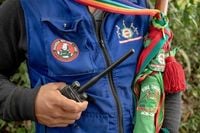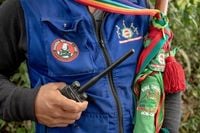At least 146 land and environmental defenders were killed or disappeared worldwide in 2024, with Latin America accounting for more than 80% of these cases, according to a report released Wednesday by the watchdog group Global Witness. The organization, based in London, found that 120 of the total killings or disappearances occurred across Latin America, cementing the region’s grim reputation as the most dangerous place on earth for people protecting their homes, communities, and natural resources.
Colombia once again topped the list as the deadliest country for environmental defenders, recording 48 killings—nearly a third of all cases globally. Guatemala followed with 20 killings, a fivefold increase from four in 2023, making it the country with the highest per capita rate of defender deaths in the world. Mexico reported 18 killings, Brazil 12, and Honduras, Chile, and Mexico each registered one disappearance. The spike in Guatemala, in particular, has raised alarms among human rights groups and environmental activists, who see the trend as a sign of deepening impunity and escalating violence.
“There are many factors that contribute to the persistent high levels of violence in Latin American countries, particularly Colombia,” Laura Furones, lead researcher of the Global Witness report, told The Associated Press. “These countries are rich in natural resources and have vast areas of land under pressure for food and feed production. Conflict over the extraction of such resources and over the use of such land often leads to violence against defenders trying to uphold their rights.”
Since 2012, Global Witness has documented more than 2,250 killings and disappearances of land and environmental defenders worldwide, with nearly three-quarters of those cases taking place in Latin America. The situation has persisted despite the adoption of the Escazu Agreement in 2018—a regional treaty designed to protect environmental defenders by requiring governments to guarantee access to environmental information, ensure public participation in environmental decision-making, and take timely measures to prevent and punish attacks.
“The Escazu Agreement provides a crucial tool for Latin America and the Caribbean,” Furones said. “But some countries have still not ratified it, and others that have are proving slow to implement and resource it properly. Stopping violence against defenders will not happen overnight, but governments must ramp up their efforts toward full implementation.”
The report highlights the disproportionate burden borne by Indigenous peoples, who accounted for around one-third of all lethal attacks worldwide in 2024, despite comprising only about 6% of the global population. A staggering 94% of all attacks on Indigenous defenders documented in the report occurred in Latin America, underscoring the particular vulnerability of these communities.
In Colombia’s southwestern Cauca region, young Indigenous people are stepping up to ensure they don’t become the next generation of victims. Through community “semilleros,” or seedbeds, children and teenagers train in environmental care, cultural traditions, and territorial defense—preparing to take on leadership roles in protecting land that faces pressure from armed groups and extractive industries. “We are defenders because our lives and territories are under threat,” Yeing Aníbal Secué, a 17-year-old Indigenous youth leader from Toribio, Cauca, told AP in July. These grassroots initiatives reflect a determination to resist violence and maintain cultural identity, even as Colombia remains the deadliest country for defenders.
Small-scale farmers were also heavily targeted, making up 35% of the victims in the region. Most killings were tied to land disputes, and many were linked to industries such as mining, logging, and agribusiness. Organized crime groups were suspected of being behind at least 42 cases, followed by private security forces and hired hitmen. The intersection of land, power, and profit continues to put defenders—especially those in rural and Indigenous communities—at grave risk.
The Amazonian department of Putumayo in southern Colombia is emblematic of the dangers defenders face. With its strategic location bridging the Andes and the Amazon, Putumayo is rich in forests, rivers, and cultural knowledge. But it also sits at the crossroads of armed conflict, extractive projects, and illicit economies. Armed groups have long used the Putumayo River as a trafficking route toward Brazil and Ecuador, where weak controls make it easier to move cocaine, minerals, and laundered money.
An environmental defender in Putumayo, who asked to remain anonymous out of fear of reprisals, described the situation to AP: “Defending rights here means living under permanent threat. We face pressure from illegal mining, oil projects tied to armed groups, deforestation, and coca cultivation. Speaking out often makes you a military target.”
Andrew Miller of the nonprofit Amazon Watch pointed to the growing influence of transnational criminal networks. “The security situation for defenders across the Amazon is increasingly precarious,” Miller said. He explained that these networks, involved in drug, gold, and timber trafficking, have become major forces behind threats—and often deadly attacks—against environmental defenders.
The challenges are daunting, and the numbers paint a stark picture. Since the Escazu Agreement was adopted in 2018, close to 1,000 cases of killings and disappearances of land and environmental defenders have been documented in Latin America alone. While the pact was hailed as a milestone for environmental justice, its uneven adoption and implementation have limited its effectiveness. Some governments have yet to ratify the agreement, and others lag in providing the resources and political will needed to enforce its protections.
The violence is not just a matter of abstract statistics. It is felt in the daily lives of people like Eduwin Calambas Fernandez, coordinator of Kiwe Thegnas (the Indigenous Guard) in the Nasa Yuwe language, who works in Canoas, an Indigenous reserve in northern Cauca. The threats faced by defenders ripple through families and communities, affecting not only those who speak out but also those who support or depend on them. The fear is palpable, but so is the resolve to continue the struggle.
Global Witness and other advocacy groups argue that urgent action is needed. They call for full ratification and implementation of the Escazu Agreement, better protection for defenders, and accountability for perpetrators of violence. They also emphasize the importance of supporting grassroots efforts, like the semilleros in Cauca, which foster resilience and leadership among young people.
For now, the risks remain high, and the path forward is uncertain. But as stories from defenders across Colombia, Guatemala, and beyond show, the fight for land, rights, and the environment continues—often at a heavy cost. The world is watching, but for those on the front lines, the struggle is personal, immediate, and, all too often, deadly.


